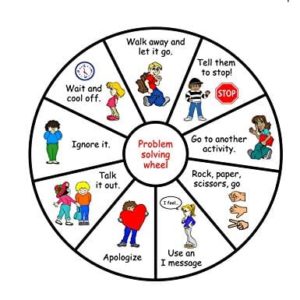Student Contributor: K. Nagamatsu
 This classroom management tool helps with getting younger students to make good decisions by themselves. If their behavior needs to be corrected they have options on the wheel and can decide for which one is the better option that goes with their particular situation.
This classroom management tool helps with getting younger students to make good decisions by themselves. If their behavior needs to be corrected they have options on the wheel and can decide for which one is the better option that goes with their particular situation.
The “Problem Solving Wheel” has many options the student can choose from such as, walk away and let it go, apologize, tell them to stop, ignore it, talk it out, and wait and cool off. Having this tool in the classroom helps minimize the fighting and arguing in the younger grade classes. It helps with giving different options that the students can choose from to handle their difficult situations themselves. For example if a student is constantly taking their classmates scissors or school supplies without asking, their behavior needs to be corrected. They can do this by going to the wheel and choosing the best option to help them make the situation better. In this case it would be to apologize to the other student who they were taking supplies from without permission.
 This classroom management tool fits into the corrective phase since it is helping the students correct their own behavior along with helping their peers correct theirs as well. This is a great behavioral corrective tool for kindergarten through 2nd grade since the wheel is giving an array of options to choose from that older students already know how to use. I found this tool to be student-directed, collaborative, and both student-directed/collaborative because it’s the students taking charge on how to fix their own behavior. And if two students are having issues with each other equally the teacher would direct both students to the wheel to have them choose how to fix the issue.
This classroom management tool fits into the corrective phase since it is helping the students correct their own behavior along with helping their peers correct theirs as well. This is a great behavioral corrective tool for kindergarten through 2nd grade since the wheel is giving an array of options to choose from that older students already know how to use. I found this tool to be student-directed, collaborative, and both student-directed/collaborative because it’s the students taking charge on how to fix their own behavior. And if two students are having issues with each other equally the teacher would direct both students to the wheel to have them choose how to fix the issue.
More Information –
Tool Source: Pinterest



I am placed in a first-grade classroom with 21 students in a suburban neighborhood. I prepared this tool by finding a wheel of choice that fit my grade level and included age-appropriate choices. I printed three copies of the wheels, laminated them, and stapled them around the room at eye level for students. I introduced the wheel at carpet time with the students, explained each choice on the wheel, and gave examples of what each one would look like in use. Since the wheels have been posted, some students have been referencing the wheel when needed and I have noticed a decrease in escalated conflicts among students. Students understand how the wheel is used and that it is their responsibility to pick a choice that is most appropriate for the situation. An adjustment that could be made to make this tool more effective would be creating a wheel of choice from scratch in collaboration with the students in your class.